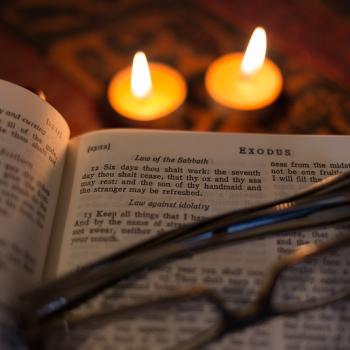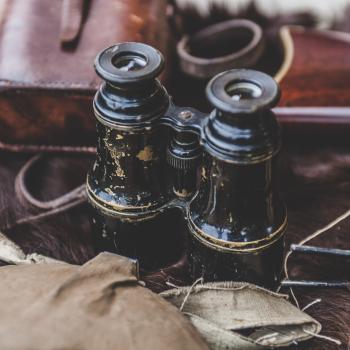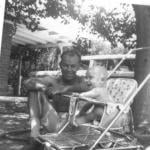**Sam and John each have different views on who is the main character in the book of Ruth. What follows is Sam’s suggestion. John will have his say later in the week.
The Mess We’re In
I don’t know if you’ve been on Facebook lately, but it’s a bit of disaster. Between politics, religion, and sports, it’s hard to find much positive on the Facebook. And I hear Twitter’s worse. But every once in a while you find that thing that keeps you coming back. One of those feel good stories that just make you smile. You know the ones I’m talking about. In a world full of terrible things, it’s just nice to hear a story that lifts your spirit, if even for a little bit. Sadly, more often than not most of these stories are about animals that treat humans better than we treat one another.
Our situation reminds me a bit of the Bible. If Judges isn’t a cesspool of sin fit for Facebook, I don’t know what is. And though we like the fun stories of the judges—Samson, Ehud, Deborah, and more, complete with really great heroes and villains—the reality is that those fun stories often overshadow a terrible reality. In just a few hundred years the Israelites had destroyed God’s vision for who they would be as a people, and the book ends with some pretty horrifying tales. It paints a picture of what happens when people remove themselves from the Lordship of God and do whatever they want. In fact the very last verse of Judges sums it up: “In those days Israel had no king; everyone did as they saw fit” (Judges 21:25). They actually were supposed to have a king. God was supposed to be King. But when they kicked God off the throne they were left to their own devices and things did not go well. They did not have a king. The result? Murder, rape, fighting among brothers and sisters—it was a disaster.

A Feel Good Story
And we need one of those feel good stories so that we don’t spiral down into complete hopelessness. Enter the story of Ruth. It is one of those feel good stories that we find in the midst of such awfulness. The story begins with a very important note about setting: “In the days when the judges ruled.” The author makes it clear that everything that comes next takes place in this setting. This setting of such degradation and sin is countered with something completely different—a story of redemption and faithfulness.
But tragedy precedes redemption. A famine causes these Israelites to move to Moab. In Moab a husband and two sons die. With nothing left there in Moab, Naomi decided to head home with her daughters-in-law.
This is an emotionally charged scene. What Naomi stated makes sense. “Go back home, return to your families and they will help provide for you. Maybe since you are young, you will remarry.” With tears we see Orpha leaves Naomi. We don’t know what happens to her, but she leaves, and Ruth stays. There is a very powerful line found in the conversations. A line that illustrates devotion, and love and a commitment to stay. The line reads, “Where you go I will go, where you stay I will stay. Your people will be my people, and your God my God.”
This is an oath pledging not to go anywhere. Ruth will stay with Naomi through thick and thin and live out her life alongside Naomi. It’s hard to really convey what an amazing sacrifice this was. She was breaking with her family, her country and her faith. I love that phrase, “Your God will be my God, and your people will be my people.” She was saying she would cherish them, identify with them, be devoted to them, live and die with them.
Ruth joining Naomi is a pretty big deal. Just like it was a pretty big deal that Naomi settled in Moab as an outsider, now Ruth is headed into a place as an outsider. She has no clue what lies ahead. Will she be rejected throughout her life for being a Moabitess? Will they even make it? Will they starve? This was a big risk for her, but she wasn’t going anywhere.
This post doesn’t have enough space to go through the whole story, but the gist is this—Ruth and Naomi settle and flourish. Despite some of the weird cultural things, it’s a nice story. It’s heartwarming. It’s a nice change of pace from the idolatry and terrible things found in Judges. God’s chosen ones looked more like a reality show gone wrong than a holy beacon of hope. They had abandoned God’s plan (again) and had become moral misfits and spiritual adulterers. The light had gone out on God’s people. Then a foreigner stepped onto the stage and a candle of hope flickered once again. The story of Ruth is a diamond in the rough that glimmers against a backdrop of blackness.
Hesed Drives the Story
That glimmer is a reflection of an ideal that we see throughout scripture. That ideal is one Hebrew word—hesed. Hesed is one of those words that is not easily translated from one language to another. Translations might use “love, steadfast love, or faithfulness.” But those don’t fully get at the richness of this word. It has to do with faithfulness to a covenant. That no matter what happens, you will keep the high expectations of the agreement you entered into.
It is what keeps married couples together despite rough times that make you just want to just get a divorce because that would be easier.
It is what keeps people who are part of the body of Christ continuing to love and work through issues with one another when it would just be easier to leave and find another church where you can be anonymous.
It is the expectation of Jesus for everyone who calls themselves a Christian—those who daily take up their cross and follow him.
It is the ideal for all who put themselves under the Lordship of God.
That’s hesed. It’s hard to put that into a translation isn’t it? But it was put on full display in the story of Ruth. In this story, we see the way in which the creation should work—according to hesed. Ruth and Boaz are held up as models of faithful living—as those who live out hesed in stark contrast to the stories found in Judges.
But they are also contrasted with 2 people in this story. Neither Orpah nor the near kinsman’s actions are called out for being wrong; they are just not equal to the extraordinary demands of hesed. This story displays the impact of right living and the blessings that follow from it. The characters are commended and rewarded for a lifestyle that takes one another’s well-being into account.
Hesed Epitomizes the Church
Part of what it means to live according to hesed is being an inclusive community. Ruth was depicted as a “Moabitess” over and over again and not an actual Israelite even up to the end of the book. For the original readers, every use of the word “Moabite” would cause a pang of anger and hostility towards the character of Ruth. And yet, as a result of her confession and her desire to follow Naomi, Ruth ends up marrying Boaz and becomes included into the nation of Israel, even the lineage of King David. Perhaps the author wanted to remind the reader that Ruth, a foreigner, was accepted into Israelite society despite her ethnicity. Ruth should have followed Orpah’s example and returned home to her own people, where she would be assured of being cared for and accepted. She chose instead to support Naomi. She chose the possibility of being ostracized because of her nationality, relegated to a second-class citizen because of her gender, and ignored because of her widowed state. Ruth’s faithful choice led to her redemption and the redemption of Naomi’s line. The redemption and restoration that are bestowed upon this seeming outsider reminds us that the riches of the kingdom of God are available to all.
This is a picture of the church. As a community, the church makes a promise: God, you will be our God and Your people will be our people. That’s what it means to be part of the church.
In spite of gender, race or any other label that separates and divides humanity, God still pours out His grace upon all humanity, ideally through the work of the church in this world. Ruth portrays this ideal story of people who desire to contribute to the community despite any obstacles that come their way. Ruth’s character provides an example of a resourceful woman who seeks the restoration of the various people in her life. Ruth challenges each of us to see where the hesed of God is breaking in, sometimes in unexpected places and people. More than that, Ruth paints the picture of the way community should be—filled with faithful people serving and caring for each other as God redeems our hopelessness and futility and produces everlasting results.
***If you are interested in a more scholarly take on this same subject, you are welcome to check out my article in the Priscilla Papers.
















